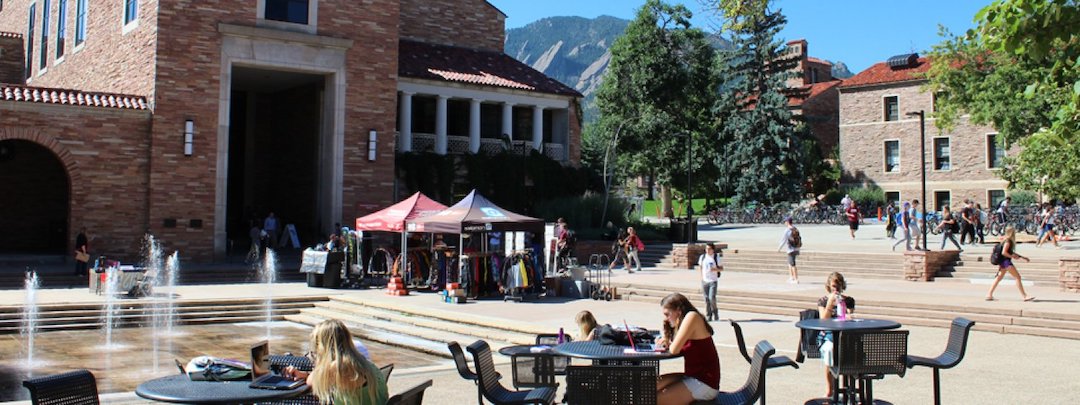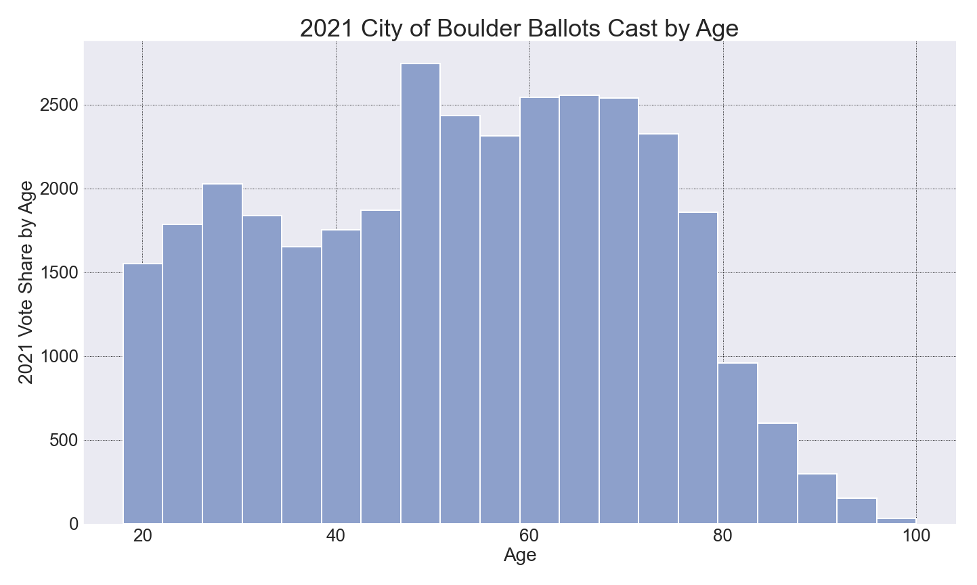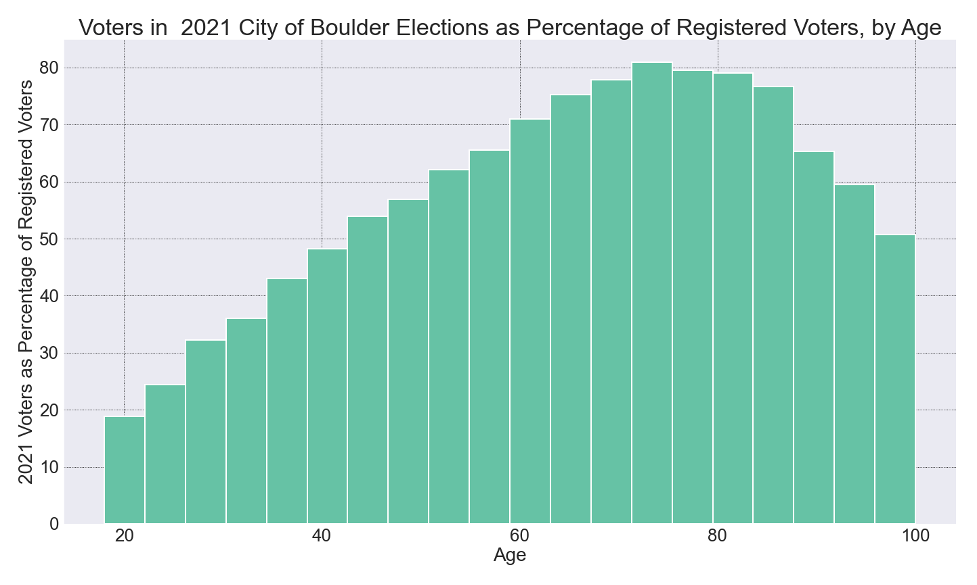Students may have tipped the balance in City Council race
Leora Frankel | Nov 12, 2021

Over the course of about 48 hours, results for the Nov. 2 Boulder City Council race went from a strong showing for the safety-focused candidates endorsed by the group Forward Boulder to a full-scale walloping by candidates from a group of social-justice campaigners calling itself The Coalition.
Since then, speculation has abounded. Not the tired conspiratorial theorizing that’s prevalent in national politics. Rather, speculation focused on two questions: Who voted on Election Day? And: Did a last-minute surge of student voting deliver victory to the Coalition side?
The graph below shows how the results flipped as the vote-counting proceeded from Election Night to two days later.

Voters could choose up to five Council members from 10 candidates on the ballot this year: four for four-year terms, and the fifth-place finisher for a two-year term. Early in the vote counting, in the lead were three candidates supported by PLAN and Forward Boulder: Council incumbent Mark Wallach along with Tara Winer and Michael Christy. Following them were two candidates endorsed by The Coalition: Matt Benjamin, who had run in 2017, and Nicole Speer. (At various points in the article, I’ll designate Forward-related candidates as “F” or, if Coalition-related, as “C”.)
But by the time the vote count had ended some two days later, the order had switched to Wallach (F), Benjamin (C), Speer (C), Lauren Folkerts (C) and Winer (F). As the lines in the above graph show, the change was dramatic.
The core slates each sported four candidates, recruited and vetted primarily by rivals Forward Boulder – the successor to Together for Boulder and rooted in neighborhood activism – and the Boulder Progressives, whose messaging may be described as woke. Leaders in both groups lean Democratic, mainstream Colorado-style, in some cases, regardless of the differing images projected. Months after the recruitment, organizations such as PLAN and the Sierra Club, endorsed one or the other slate, in both cases adding a fifth candidate.
To understand why the results postings over a 48-hour period are like snapshots of voting behavior, you need to know that the ballots are counted in chronological order. We are treated to ballot mixes that shift over time in a fairly predictable pattern. Residents tend to cast their votes early or late, depending on a few factors, age foremost among them. This year, 47% of the participating 33,800 or so voters cast their ballots on November 2, Election Day.
Student voters and pizza
I became aware of the power of the student vote in 2017. It’s funny to make that statement, as the sheer number of students in Boulder – about 35,000 enrolled at the University of Colorado (CU) out of a total city population of approximately 106,000 – would suggest a towering wave of ballots capable of drowning any opposition. But until recently, most activists and campaign leaders held the opposite view, namely, that because only a small percentage of students vote in Boulder, resources expended on courting this group were resources wasted.
In the elections four years ago, New Era Colorado, a political group aimed at young people, took CU students seriously. Distributing free pizza, New Era staff pumped up students on ballot Issue 2L, a lifeline for the years-long drive to municipalize Boulder’s electrical system (unartfully dubbed “the muni”). According to an article in the Daily Camera, New Era provided rides for 428 students to an on-campus voting center and facilitated 2,075 voter registrations (not necessarily on Election Day). At 7 p.m. on Election Day that year, students were still lined up to vote. Many had pledged to New Era that they would support the environmentalist 2L, which was also fervently endorsed by PLAN.
Ballot Issue 2L surged in late voting from a defeat by 12% in an early tally to a win by about 1,000 votes. The late vote also lifted pro-muni, PLAN-endorsed candidate Mirabai Nagle, securing her a four-year Council seat.
An indefatigable anti-muni activist named Patrick Murphy filed a complaint with the Boulder District Attorney, alleging that “New Era was offering something of value in exchange for a vote, whether that is a ride to the polls or a piece of pizza. This is a huge no no.”
The DA disagreed, finding no violation of campaign finance laws.
But the students’ concentration of electoral power did not go unnoticed.
Student voters and hovering Boulder adults
Two years later, on Election Day of 2019, I visited the University Memorial Center — the UMC — on campus, where an in-person voting location and ballot drop box were now situated upstairs near the ballroom (no more New Era rides across campus!). I was assisting my friend Corina Julca with her run for the Council.
Both sides were out in a display of determination.
In one incident, the campus police had to intervene to halt the harassment of Gary Wockner, an anti-growth environmental activist, by Mark Gelband, an activist well-known for crusading against perceived racism. Both are adult, white men.
Meanwhile, the CU students seemed to be behaving well, perhaps showing signs of election fatigue. Many seemed weary of answering campaigners’ questions about whether they had voted yet.
One campaigner on the scene was CU law student Junie Joseph, galvanizing support for herself and other candidates endorsed that year by the groups Boulder Progressives, Better Boulder and Open Boulder. Their side had used social media outreach and advertising skillfully. However, the PLAN/Together4Boulder slate was holding its own. Between Julca, an immigrant from Peru, and Adam Swetlik, a young CU alum, both dedicated advocates for affordable housing, the students seemed interested in this slate too, occasionally even requesting selfies (Julca was not elected but Swetlik just concluded a two-year Council term).
The campus had it all: same-day voter registration and voting, quick and easy.
“The muni” was still alive at that point, providing one climate-change talking point for PLAN candidates, while the Boulder Progressives were stressing the diversity of their slate. Students, it seemed, related to both types of appeals.
This year, students hear just one side
When Election Day 2021 came around, the PLAN/Forward slate largely surrendered the CU campus to The Coalition, whose strategists deployed volunteers and candidates around the UMC, engaging students. Their slate included two of this year’s winners: a CU employee, Nicole Speer, PhD, who is the director of a brain imaging center at the Institute for Cognitive Science; and a former CU employee and alum, Matt Benjamin, who had worked as an astronomer at Fiske Planetarium. But it was architect Lauren Folkerts, campaigning energetically on-site, who benefited most from the huge surge of late votes, from students or otherwise.
So where was the other side? I asked this question of Tara Winer, a PLAN-endorsed winning candidate soon to be sworn in on Council. It wasn’t so much a strategic choice, she said, as more of no choice. “We didn’t have a powerhouse going door to door. [The other side] were more organized.”
Winer attributed The Coalition’s mobilization of volunteers to enthusiasm generated by Ballot Measure 300, “Bedrooms are for People,” which aimed to increase rental occupancy limits and was clearly a hot topic on campus. (Ultimately, the measure was defeated despite benefiting from a late surge.) And some of the volunteers who might have been out campaigning for her slate were instead trying to garner support for (the eventually failing) Ballot Measure 302, “Let the Voters Decide on Annexation of CU South,” and gathering signatures for a petition that was to successfully mandate a referendum next year on the CU South annexation. Yet others were waging battle against Measure 300. “Who did I have? Just me,” Winer said. Well, she added, her family also helped a lot.
OK, OK, but did the student vote matter?
There are a couple of ways to try to answer that question.
The following graph shows the breakdown by age of voters in this year’s Boulder elections.

Only 1,957 people in the 18-to-23-year-old range voted in this election. Of these voters, the majority voted on Election Day: 1,156. Note that they constitute less than a tenth of the total election-day vote of 15,936. Consider, too, that not all of these young people are students. Conversely, approximately 6,000 graduate students are enrolled at CU, many of whom are older than age 23. They are also more likely to vote, as residency is often required for PhD programs. So the student vote would show up in a second age group too.
Mircalla Wozniak of the Elections Division in the county’s Clerk and Recorder’s Office patiently assisted me in arriving at other estimates of on-campus voting. The total number of in-person votes cast at the UMC was 377. An additional 93 voters picked up a mail-in ballot at the UMC, possibly to drop off later. The contents of the on-campus ballot drop boxes are estimated by weight. These are approximate and almost certainly contain some non-student votes. The ballot total collected at CU was 3,211. Of these, 2,039 constitute Election Day ballot drops.
On the one hand, we see the youngest age group showing a low voter turnout of only 19%, as illustrated in the next graph. On the other hand, we do see a significant and disproportionately high Election Day vote on campus.

Looked at another way, the difference between Folkerts (C) in fourth place and Christy (F) in sixth place is 1,170 votes. A swing of about 590 votes from the candidate in fourth to the candidate in sixth place would be enough to have triggered a swap, altering the makeup of the City Council. If the students (and other on-campus voters) this year constituted a fairly uniform voting bloc, then their ballots would have been more than sufficient to deliver a surprise win to Folkerts.
But then you could say the same for any group of voters on that final day. While the younger generation tended to vote late, less than 30% of those aged 65 and over waited until Nov. 2. The early vote was older and leaned towards the Forward/PLAN slate. The later vote skewed younger and leaned towards the Coalition slate.
Nevertheless, I would argue that, purely from a campaigning perspective, CU votes are different: the concentration of so many thousands of people in one location, within steps of ballot drop boxes and polling booths, makes it easier for candidates to notch last-minute gains.
The end of an era
Former City Council Member Macon Cowles tweeted exultantly on Nov. 6: “Grey Beards have lost their grip on Boulder.” (Cowles is in his 70s.) For the next two years and possibly beyond, The Coalition will hold a majority on the City Council, likely lifting rental occupancy limits, finalizing the CU South annexation, and perhaps embarking on the rezoning or reimagining of residential neighborhoods. Is this a changing of the guard – a generational conflict settled at this year’s ballot box?
This election cycle was dominated by two citizen-initiated ballot measures: 300 and 302, both of which were defeated. While the Coalition slate benefited from the energy associated with the Bedrooms initiative (its candidates wholeheartedly endorsed the measure), the Forward slate failed to benefit from the CU-South-annexation ballot measure. Forward candidates, for the most part, deferred to then-Mayor Sam Weaver and to Council Member Wallach, who had both voted in support of the annexation and have continued to defend it.
Former Council Member Spense Havlick, in a guest opinion in the Daily Camera, hit the nail on the head on the disconnect between City Council and the citizens of Boulder, in the context of the CU South decision:
“And so, when challenged by citizens, they [Council Members] retreat and avoid actually engaging with those who are confronting them. Their ability to avoid engagement has been enhanced in recent years by the COVID-19 situation and the resulting change from in-person meetings to on-line Zoom type events, where ordinary citizens are just images on a screen, and easily dismissed.
This appears to be what’s been going on with the current Council. There are far too many votes that are unanimous or nearly so, and far too little needed disagreement and the resulting serious discussion over issues that are legitimately contentious.”
The general populace may still prefer to vote for incumbents, as Wallach’s results show, but would-be volunteers may have noted the abandoned campaign promises, the lofty disconnects, and the dealmaking on City Council – and stopped showing up for candidates. Foremost among the broken promises this term were the forsaken “muni” and the Council’s vote to annex CU South by emergency measure.
The use of slates enables organized groups to concentrate funds and volunteer efforts on behalf of individuals who will supposedly fulfill their agenda. This has turned out to be a false assumption. The slates have the additional effect of harming independent candidates, such as Jacques Decalo and David Takahashi this year. Takahashi, in particular, was a stellar environmentalist candidate, endorsed by no less a figure than Bill McKibben. Yet he came in ninth out of 10.
Factions in future elections hard to predict
The most consistent messaging that distinguishes the two slates is faster growth vs slower growth; higher density vs lower density. But the people behind the slates have sometimes been a shifting cast. For example, in 2017 local telecom tycoon Dan Caruso threw money at the predecessors of the Boulder Progressives. This year, a new organization, Safer Boulder, directed the focus of the Forward Boulder slate toward a campaign against crime and homeless encampments.
Students and other young voters are unlikely to do the research to find out the agendas behind each slate. The platform presented by Forward Boulder this year was destined to be unappealing to this population. The Coalition’s platform was, by contrast, wildly successful among the younger generation. PLAN’s reputation among many on campus is that of a bunch of home-owning nay-sayers. Many observers and participants have lamented the uncivil and often painfully personal attacks, which emanated primarily from The Coalition during this election season. As with other quandaries raised here, it’s hard to assess whether these tactics brought their candidates to victory; the three successful candidates were themselves personable to the point of being safely bland during public forums.
None of this is predictive of the next election or the one after that. The organizations behind slates may continue to morph. They may proliferate or vanish. Alliances may be detrimental, as the fallout between Council Member Bob Yates and his former running mates shows. The partnership between Better Boulder, with its heavyweight local developers, and the young, disaffected followers of the Boulder Progressives, may or may not survive. Ultimately, climate change will increasingly predominate our psyche, alongside and intertwined with social justice issues. Popularity rises and wanes, as those in positions of power disappoint their followers.
POSTSCRIPT: All numbers presented and analyzed in this article are based on results as of Nov. 9, one week after the election.

Author Leora Frankel has written previously for Boulder Reporter on topics that have included the local air-quality effects of fracking and the uber-large profits available to investors and developers from tax-sheltered Opportunity Zones.

Chris, In reply to the questions in your earlier comment: The overall ballot returns for the City of Boulder elections 2021 are still estimated at about 33,800. The official election results are to be posted on November 23, according to the County Clerk and Recorder’s website. As for city council members who are renters, my research shows there is only one: Junie Joseph. All the others live in homes that either they or their partners own.
What do you mean by “the fallout between Council Member Bob Yates and his former running mates”? I’m very curious and that sentence seems dropped in without any context.
Ms. Frankel is by far the best journalist in Boulder in documenting the real political trends in Boulder that the candidates do not talk about, especially compared with the alcohol-fueled Twitter bot Castle. And she always is aware of who has the money and how it is being spent. The Prog/Developer coalition, which exists all over, not just in Boulder, and its money, is the real issue and it is completely hidden from the public. The coalition this election between Yates (and by extension Tebo and Reynolds) and the PLAN candidates was shameful, and Weaver/Young axis selling out the Muni and CU South has left the liberals demoralized, disorganized, and disgusted. As a longtime PLAN supporter, you’re offering me up Wallach and Christy, are you kidding! It is just part of a long tradition of the PLAN side supporting candidates who sell out their supporters, i.e., Cowles, Applebaum, Young, even Toor. and while the Progs have functionally controlled the council for at least two years, they now are visibly in control with the election of manipulator Brockett as mayor (but not for long with the 2023 change). But the dismal failure of 302 indicates to me it is time to give up on slow growth Boulder and that there will be no voter backlash to the chaos this new council will cause, primarily the end of single-family zoning and the opening up of every backyard in Boulder to a new full-sized house or three-bedroom condo (none of which will be affordable, see Whittier). Perhaps overreach on the homeless issue will result in a backlash, but I doubt it. And Yates near-total loss of power means he will not be able to enforce payback against his business buddies at the Chamber and Better Boulder who supported the Progs, and we will see him fade away in 2023 when he fails to win mayor, as a victim of rank choice voting which he inadvertently help pass in his time with the Coalition.
Wow, what terrific reporting and analysis. I read the Camera daily, and I had no idea of what your describing here. I don’t pay as much attention to the local scene as I should and I feel way more up to speed thanks to this article.
What a terrific analysis! I read the Camera every day, and I did not really understand what happened till reading this. I’m not always as plugged into local politics as I would like to be – though I love and care about Boulder. I feel like I’ve been brought up to date. Thanks!
Sad to say, but the “Forward” team was outfoxed, outspent and outhustled by the so called Progressives (and WHEN was THAT moniker claimed in such an Orwellian fashion by the pro-development faction?). This is especially true in the cultivation of the CU vote. Perhaps after the impact of this election begins to be seen, as traffic congestion swells, more trashy, unkept rentals appear in what were once tidy family neighborhoods, and the entire town devolves into a gigantic “Hill” environment, the “Forwards” will have another chance to make their case. But, of course, it will be too late by then. BTW – I am no newcomer to Boulder politics and elections, having lived here since 1974. Seen a LOT in those years, now with increasing distress.
What was the final turnout? How many on the new Council are renters?
Your last sentence reminds me of something that the late great Senator Mike Gravel, who read the Pentagon papers during his solo filibuster to end the Vietnam draft in 1971, liked to say:
“There are no exceptions to ‘power corrupts’.”
(When I mentioned this to Senator Mark Udall’s brother Randy, he said, “Yes, I know this from growing up in a political family. Well, I just condemned my brother, cousin, father and uncle!”)
This is why we have direct democracy, the ultimate check and balance on politicians when they betray us or fail to represent us. And why online petitioning is important so direct democracy isn’t just available to the wealthy who have time & money to collect thousands of signatures in person.
Please, everyone, ask city council to fix the online petitioning software. It’s quite straightforward.